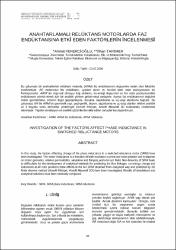Anahtarlamalı relüktans motorlarda faz endüktansına etki eden faktörlerin incelenmesi
Abstract
Bu çalışmada bir anahtarlamalı relüktans motorda, (ARM) faz endüktansının değişimine neden olan faktörler incelenmiştir. AR motorunun faz endüktansı, uyartım akımı ve hareket eden rotor pozisyonunun bir fonksiyonudur. ARM’nin doğrusal olmayışı bağ akılarını, ko–enerji değişimini ve her rotor pozisyonundaki endüktansını tahmin etmek için bir analitik yöntem geliştirmeyi zorlaştırır. Ayrıca faz endüktansının değişimi motor geometrisine, ortamın bağıl geçirgenliğine, doyuma, saçaklanma ve uç-sargı alanlarına bağlıdır. Bu çalışmada, 6/4 bir ARM’de geometrik yapı, geçirgenlik, doyum, saçaklanma ve uç-sargı alanları etkileri analitik ve 3 boyutlu sonlu elemanlar yöntemiyle (Ansoft RMxprt, Ansoft Maxwell 3D kullanarak) incelenmek istenmiştir. Yapılan simülasyon ve analitik çözümlerden elde edilen sonuçlar karşılaştırılmıştır. In this study, the factors affecting change of the phase inductance in a switched reluctance motor (SRM) have been investigated. The motor inductance is a function of both excitation current and rotor position and it depends on motor geometry, relative permeability, saturation and fringing and end-turn field. Non-linearity of SRM leads to difficulties for the development of analytical methods for predicting the flux linkages, co& #8211; energy change and inductance at all rotor positions these effects in the 6/4 SRM obtained from analytical way and predicted by 3D finite element method (Ansoft RMxprt, Ansoft Maxwell 3D) have been investigated. Results of simulations and analytical solutions have been relatively compared.


















